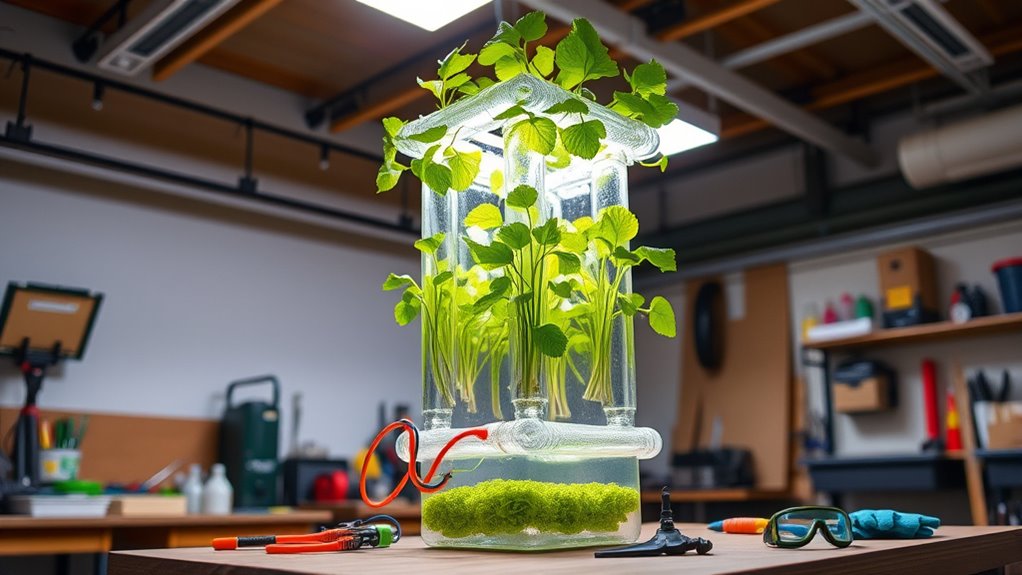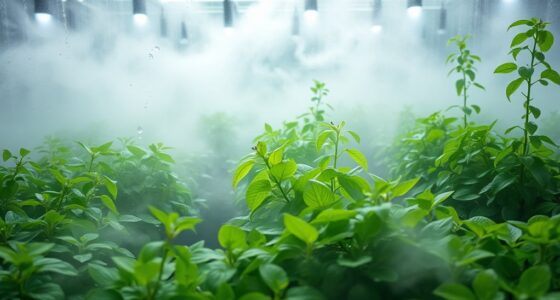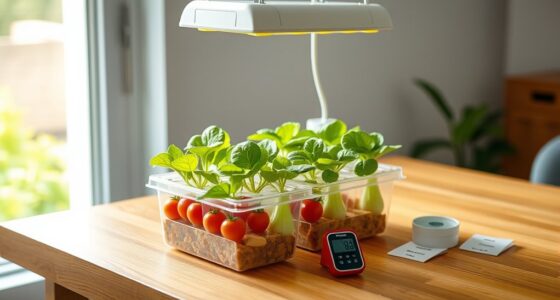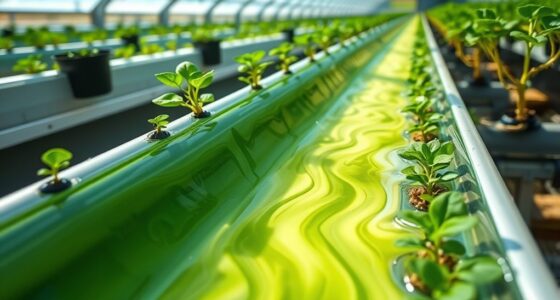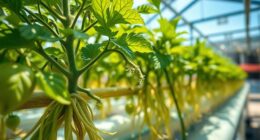To construct your own hydroponic setup, begin by designing a layout that guarantees sufficient lighting, airflow, and space for upkeep. Select sturdy, easy-to-clean parts such as high-grade pumps, tubing, and containers, and place everything for ideal water and nutrient circulation. Don’t overlook safety inspections—correct wiring, grounding, and structural reinforcement are vital. Tracking pH, temperature, and plant health is also essential. Keep these factors in mind to create a dependable system that fosters healthy growth—you’ll find more tips along the way.
Key Takeaways
- Plan system layout with adequate lighting, airflow, and clear pathways to optimize plant growth and ease maintenance.
- Select durable, easy-to-clean components like containers, tubing, and pumps to prevent pests and contamination.
- Ensure proper water and nutrient circulation by maintaining pump functionality, checking for leaks, and balancing pH levels.
- Implement electrical safety with grounded wiring, waterproof connectors, and regular inspections to prevent shocks and damage.
- Regularly monitor pH, water temperature, and plant health to detect issues early and promote healthy growth.
Planning Your Hydroponic System Layout

Before building your hydroponic system, you need to plan its layout carefully to maximize space and efficiency. Start by considering lighting needs; ensure your plants receive adequate light, either from natural sources or supplemental grow lights, to promote healthy growth. Proper lighting placement also helps prevent pests by reducing dark, damp areas that attract unwanted insects. When arranging your system, think about pest control strategies—keep pathways clear for easy inspection and maintenance, and avoid clutter that can harbor pests. Adequate spacing between plants improves airflow, reducing disease risk and making pest management simpler. Planning your layout with these considerations in mind helps create a productive, pest-resistant environment, ensuring your hydroponic setup runs smoothly from the start. Additionally, incorporating vegetable juices into your gardening routine can boost plant health by providing essential antioxidants and nutrients that support overall growth.
Selecting the Right Components and Materials
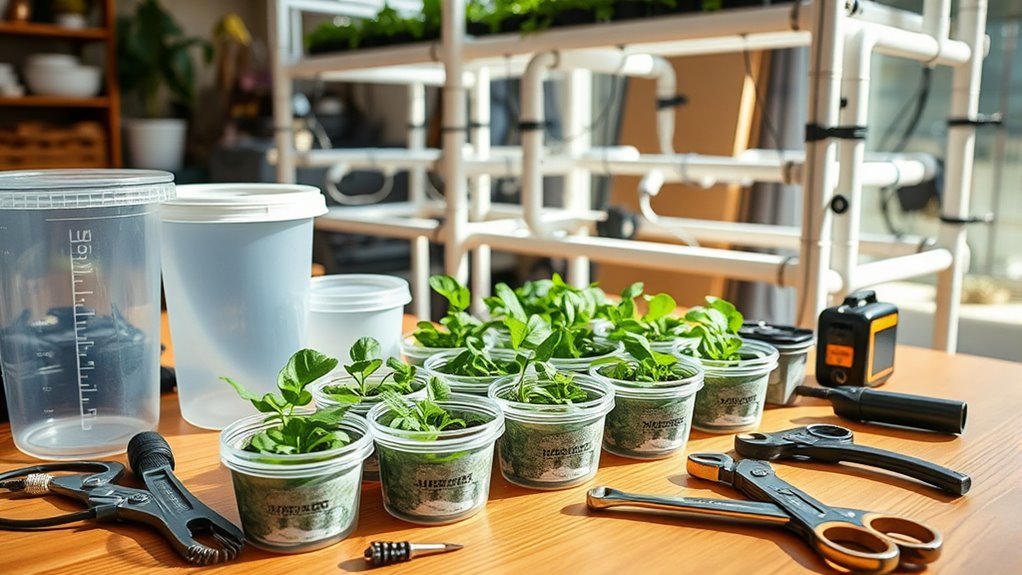
Choosing the right components and materials is essential to building a reliable and efficient hydroponic system. Start by selecting durable containers and reservoirs that resist pests and prevent contamination. When it comes to pest control, opt for materials that are easy to clean and maintain, reducing the risk of mold and infestations. Lighting optimization is also key: choose reflective surfaces and appropriate lighting fixtures to maximize plant growth while minimizing energy use. Use high-quality pumps, tubing, and filters designed for hydroponic environments to ensure smooth water and nutrient flow. Avoid cheap, low-grade materials that might degrade or harbor pests over time. Additionally, selecting appropriate lighting tools and ensuring proper placement can significantly impact your system’s effectiveness. By carefully selecting your components, you’ll set a strong foundation for a healthy, productive hydroponic setup.
Ensuring Proper Water and Nutrient Circulation
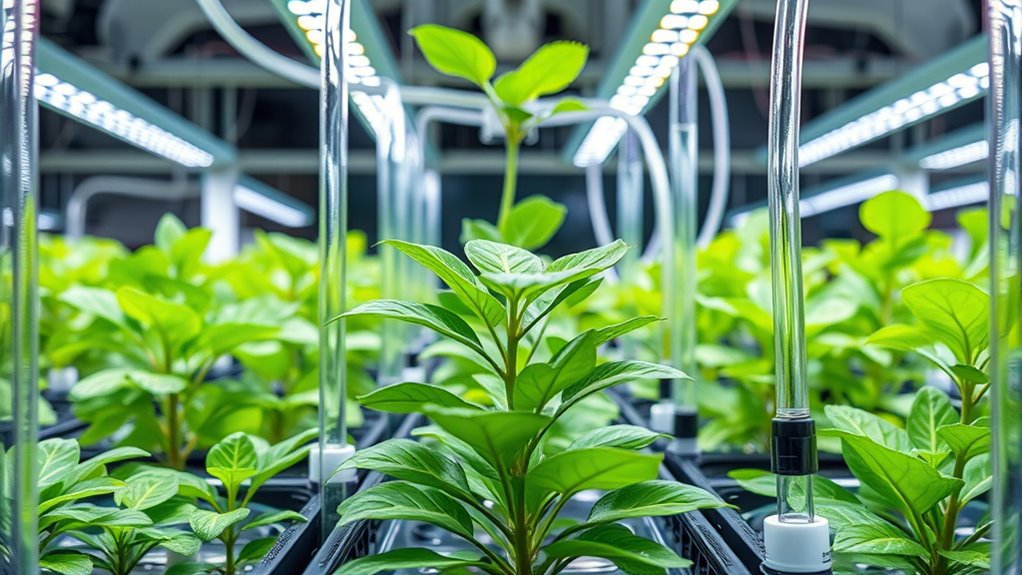
To guarantee your plants receive consistent nutrients and ideal growth, proper water and nutrient circulation is essential. Start by ensuring your pump functions smoothly; regular pump maintenance prevents clogs and breakdowns. Check for leaks and clean filters to keep water flowing freely. Maintaining correct pH balancing is crucial, as imbalanced pH can hinder nutrient absorption. Use a reliable pH meter and adjust nutrient solutions accordingly. Consistent circulation distributes nutrients evenly, preventing stagnation and root rot. Ensure your system’s tubing and channels are clear and properly positioned to promote steady flow. Regularly monitor water movement, and adjust pump settings if necessary. Proper circulation keeps roots oxygenated and nourished, supporting healthy plant development throughout your hydroponic setup. Additionally, ensuring proper air circulation helps maintain optimal oxygen levels in the water and roots.
Implementing Safety Measures for Electrical and Structural Integrity
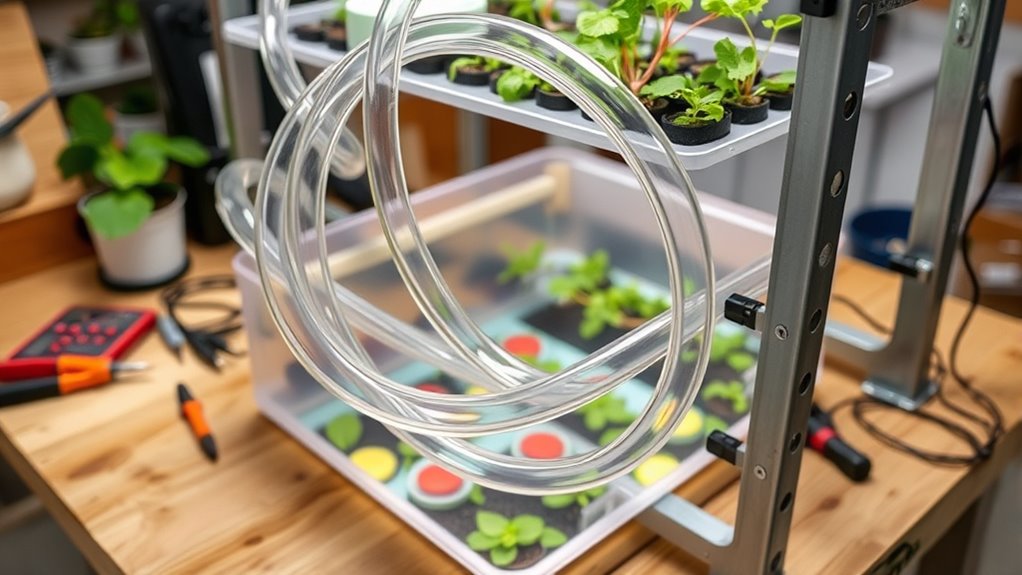
Ensuring the safety of your hydroponic system involves taking proactive steps to protect both your electrical components and structural setup. Start by implementing proper grounding techniques to prevent electrical shocks and short circuits. Use insulated wiring and connect all electrical devices securely to grounded outlets. Waterproof connectors are essential for outdoor or humid environments; they prevent moisture from causing corrosion or electrical failures. Make certain all connections are tight and sealed to avoid water ingress. Regularly inspect your wiring for signs of wear or damage. Strengthen your system’s structure by securely anchoring supports and checking for stability. Additionally, understanding the contrast ratio can help you optimize your system’s visual setup for better monitoring and management. These precautions reduce risks of electrical hazards or structural collapse, ensuring a safe, reliable hydroponic setup that functions efficiently over time.
Testing and Monitoring Your System for Optimal Growth
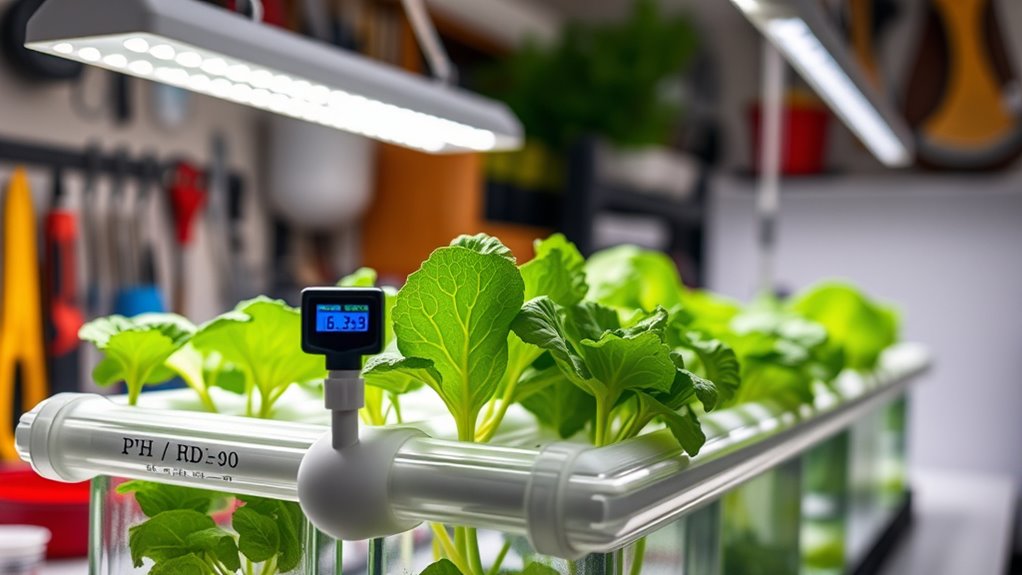
Regular testing and monitoring are essential to keep your hydroponic system running at peak performance. You should regularly check the pH levels of your nutrient solution, aiming for ideal pH balancing to ensure plants absorb nutrients effectively. Consistently monitor water temperature and oxygen levels to prevent stress and promote growth. Keep a close eye on the health of your plants, watching for signs of pest prevention issues like pests or disease. Use a magnifying glass if needed, and inspect roots regularly for any problems. Recording your data helps identify trends and makes adjustments easier. Staying vigilant with testing and monitoring not only maximizes growth but also helps catch potential issues early, saving you time and resources while maintaining a healthy, productive system. Additionally, be aware that signs of spoilage in your nutrient solution or water can indicate contamination, so regular checks can help maintain system safety.
Frequently Asked Questions
How Do I Troubleshoot Common Problems in My Hydroponic System?
When troubleshooting your hydroponic system, start by checking for pH imbalance, which can hinder plant growth. Test and adjust the pH levels to keep them within the ideal range. Also, inspect for system clogging, especially in the pumps and hoses, which can restrict water flow. Clear any blockages you find and guarantee your system is clean. Regular maintenance helps prevent these issues and keeps your plants thriving.
Can I Customize My System for Different Plant Types?
Absolutely, you can customize your hydroponic system for different plant types by making plant-specific adjustments. A modular system design makes this easier, allowing you to swap out components or modify nutrient delivery methods tailored to each plant’s needs. You should consider factors like light, nutrient concentration, and root space, ensuring each plant gets ideal conditions. This flexibility helps maximize growth and health across diverse plant varieties.
What Are the Most Cost-Effective Materials for DIY Hydroponics?
For DIY hydroponics, you want cost-effective materials that save money without sacrificing quality. Use PVC pipes or food-grade plastic containers for the grow channels, as they’re affordable and durable. You can also repurpose old containers or totes to create your reservoir. Affordable grow lights, like LED strips, are great for energy efficiency. By choosing these cost-effective materials, you’ll build a functional, budget-friendly hydroponic system that’s easy to maintain.
How Often Should I Replace Nutrients or Water in My System?
Think of your hydroponic system as a car that needs regular fuel and maintenance. You should check nutrient concentration and water quality weekly. Replace the water every 1-2 weeks to prevent buildup of salts and contaminants. Nutrients should be replenished as needed, usually during water changes, to keep plants healthy. Monitoring closely guarantees your system runs smoothly, giving your plants the fresh “fuel” they need to thrive.
Are There Eco-Friendly Alternatives for System Components?
You can definitely choose eco-friendly components for your hydroponic system by opting for sustainable materials like recycled plastics, bamboo, or biodegradable net pots. These eco-conscious design choices reduce environmental impact and promote sustainability. Look for suppliers that prioritize green manufacturing practices, and consider using energy-efficient pumps and LED grow lights. By selecting eco-friendly components, you help protect the planet while maintaining a successful, sustainable hydroponic setup.
Conclusion
Building your own hydroponic system is both rewarding and efficient. Did you know that hydroponic farms can produce up to 25% more crops in half the time compared to traditional soil methods? By carefully planning, selecting quality components, and prioritizing safety, you set yourself up for success. Regular testing and monitoring guarantee your plants thrive. With dedication, you’ll enjoy fresh produce year-round and a deeper understanding of sustainable gardening.
